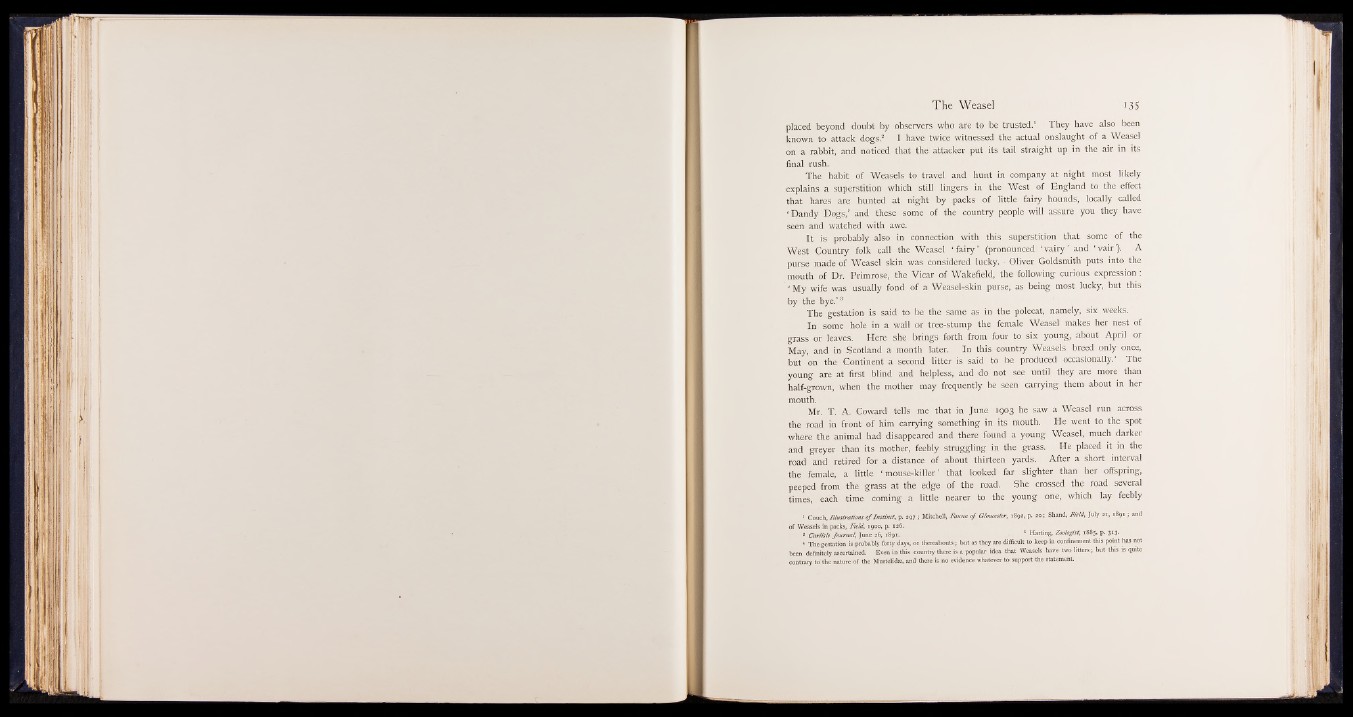
placed beyond doubt by observers who are to be trusted.1 They have also been
known to attack dogs.2 I have twice witnessed the actual onslaught of a Weasel
on a rabbit, and noticed that the attacker put its tail straight up in the air in its
final rush.
The habit of Weasels to travel and hunt in company at night most likely
explains a superstition which still lingers in the West of England to the effect
that hares are hunted at night by packs of little fairy hounds, locally called
‘ Dandy Dogs,’ and these some of the country people will assure you they have
seen and watched with awe.
It is probably also in connection with this superstition that some of the
West Country folk call the Weasel ‘ fairy’ (pronounced ‘ v a iry ’ and ‘ v a ir’). A
purse made of Weasel skin was considered lucky. • Oliver Goldsmith puts into the
mouth of Dr. Primrose, the Vicar of Wakefield, the following curious expression :
‘ M y wife was usually fond of a Weasel-skin purse, as being most lucky, but this
by the bye.’ 8
The gestation is said to be the same as in the polecat, namely, six weeks.
In some hole in a wall or tree-stump the female Weasel makes her nest of
grass or leaves. Here she brings forth from four to six young, about April or
May, and in Scotland a month later. In this country Weasels breed only once,
but on the Continent a second litter is said to be produced occasionally.4 The
young are at first blind and helpless, and do not see until they are more than
half-grown, when the mother may frequently be seen carrying them about in her
mouth.
Mr. T. A. Coward tells me that in June 1903 he saw a Weasel run across
the road in front of him carrying something in its mouth. He went to the spot
where the animal had disappeared and there found a young Weasel, much darker
and greyer than its mother, feebly struggling in the grass. He placed it in the
road and retired for a distance of about thirteen yards. After a short interval
the female, a little ‘ mouse-killer ’ that looked far slighter than her offspring,
peeped from the grass at the edge of the road. She crossed the road several
times, each time coming a little nearer to the young one, which lay feebly
1 Couch, Illustrations o f Instinct, p. 297; Mitchell, Fauna of Gloucester, 1892, p. 20; Shand, Field, July 21, 1891; and
of Weasels in packs, Field, 1900, p. 126.
* Carlisle Journal, June 26, 1891. . 3 Halting, Zoologist, 1885, p. 3x3.
•i The gestation is probably forty days, or thereabouts; but as they are difficult to keep in confinement this point has not
been definitely ascertained. Even in this country there is a popular idea that Weasels have two litters; but this is quite
contrary to the nature of the Mustelid®, and there is no evidence whatever to support the statement.